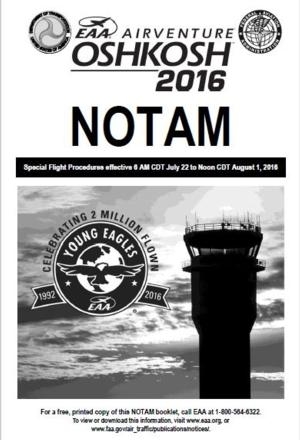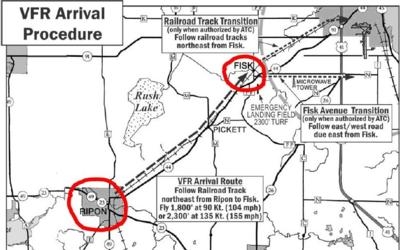Here Are Some Of The 'Tricks Of The Trade' When Flying Into EAA AirVenture
This is the second of a 6-part series by Earl Downs that we hope will help pilots who have never flown into EAA AirVenture Oshkosh and landed at Wittman Regional Airport. The remaining parts of our “how to” series will be published every Friday over the next four weeks.

For a recreational flyer, flying into Wittman Regional Airport during EAA AirVenture is part of the adventure. You’ll probably hear some wild stories about the arrival and departure procedures, but if you are prepared, it’s a lot of fun. Our purpose here is to discuss various things that aren’t necessarily connected, but they are addressed in the NOTAM and could use some amplification. Here we go with ‘This n’ That.’
Be Legal
If the FAA wanted to, they could put hundreds of inspectors on the ground at Wittman Regional Airport during AirVenture and perform thousands of ramp checks. That does not happen at AirVenture, but it doesn’t mean the FAA will shirk their duties in the event of some sort of problem or incident. Make sure your flight review is up-to-date, be in compliance with the medical regulations, and double check that you have all personal and aircraft documents in order.
Alternate Airport
Be prepared to use an alternate airport, and if the airport you plan on is included on the NOTAM, be sure you are familiar with procedures at that airport. Once again, understanding the NOTAM and being prepared to quickly reference information is of paramount importance.
Radio Communication
As you approach the VFR initial approach point at the city of Ripon, the NOTAM advises you to listen to the ATIS frequency and then switch over to Fisk approach control and start listening…I assure you, you will hear radio communications like you have never heard before; it’s incredible! By the way, no communication takes place at Ripon.
Do not expect to use your aircraft N-number for identification purposes. For the most part, airplanes will be identified by their type, or color, or some general term that gives a clue that they are looking at you. Before you go, think up some sort of identification that you could use that does not involve your N-number. For example, If I’m flying my Zenith Zodiac that is painted white with pronounced yellow trim, I might call myself a, “white and yellow experimental”…I could also throw in the term, “low-wing.”

As you approach the town of Fisk, the controllers will visually pick you up and give you a call using some sort of identification that they perceive as unique from other airplanes within their sight. They commonly will ask you to “rock your wings” to verify communication. Whatever they choose to use in identifying you, use that as your call sign. Remember, you may not proceed beyond Fisk unless you’re sure you have been identified and given a clearance. If you have to call them, the conversation might go something like this, “Fisk approach…white and red Cessna is over Fisk, have you identified me?” You’ll probably be asked for a ‘wing rock’ and then be given the transition clearance from Fisk for your landing runway.
When in the actual pattern for landing the tower will call you, you don’t have to call them. However, if you have doubt give them a shout with your aircraft description. If a controller clears you to land in a specific place such as, “Cessna behind the white and yellow experimental, cleared to land on the orange dot,” be sure to confirm the clearance. Your reply might go something like, “Cessna orange dot, Wilco.”
Be concise with terminology by using terms such as, “affirmative,” “negative,” “Wilco” (will comply), and “say again.” Remember, the word “Roger” only confirms that you heard their transmission but does not verify compliance with instructions.
Also keep in mind that multiple frequencies are being used for the different runways and for takeoffs and departures. If you think there is a runway conflict, let the tower know and be prepared for a go around, but if the tower says everything is good, it simply means you’re not hearing the other communication and that they know what they’re talking about.
Listen to all communications very carefully for two reasons. First, you want to make sure you don’t respond to a communication that’s actually intended for someone else. The second reason is for situation awareness. Try to figure out who’s in front of you and who’s behind you by listening to the clearances provided by the Fisk controllers. For example, if you hear them give a request for wing rocking and you see the airplane in front of you rock its wings, you will be next.
Visual Navigation
The flight from your initial VFR entry point at Ripon to your clearance point of Fisk is achieved by following railroad tracks between the two towns. GPS coordinates are provided but GPS should not be used for primary navigation; look out the window and navigate by visual reference. Using an autopilot may sound like an easy way to hold your altitude and airspeed, but it makes about as much sense as engaging cruise control on an extremely busy highway in rush hour. Apply your pilot skills and hand-fly the airplane.
Traffic Separation
From the town of Ripon to Fisk, there is no separation of traffic by means of ground controllers…it’s up to each pilot to pay attention and remain a safe distance from other aircraft. The NOTAM recommends no closer than one half mile but you will probably see aircraft closer than that. As you cross over Ripon, I would highly recommend turning on any lights you have that can help other aircraft see you. Heck, if you have a smoke system, give it a puff every now and again.
Coming Up
In our next segment for ‘Flying Into AirVenture,’ I’m going to review the performance-specific maneuvers and go over some preshow practice that may help dial-up your pilot skills. Enjoy your flying experience at AirVenture; it will provide you with ‘war stories’ that will last until next year.
(Images from EAA/FAA NOTAM)
 ANN's Daily Aero-Term (04.24.24): Runway Lead-in Light System
ANN's Daily Aero-Term (04.24.24): Runway Lead-in Light System ANN's Daily Aero-Linx (04.24.24)
ANN's Daily Aero-Linx (04.24.24) Aero-FAQ: Dave Juwel's Aviation Marketing Stories -- ITBOA BNITBOB
Aero-FAQ: Dave Juwel's Aviation Marketing Stories -- ITBOA BNITBOB Classic Aero-TV: Best Seat in The House -- 'Inside' The AeroShell Aerobatic Team
Classic Aero-TV: Best Seat in The House -- 'Inside' The AeroShell Aerobatic Team Airborne Affordable Flyers 04.18.24: CarbonCub UL, Fisher, Affordable Flyer Expo
Airborne Affordable Flyers 04.18.24: CarbonCub UL, Fisher, Affordable Flyer Expo




